Why is this image one of the most famous works of the Renaissance? Raphael created a unique composition that seems like a heavenly vision. The Virgin carries the Christ Child over the clouds down to Earth. Saint Barbara and Pope Sixtus form a large triangle with her. This heightens the presence of the painting, which stood on the main altar of San Sisto in Piacenza and whose impact must have been felt throughout the church. The cherubs waiting for Mass draw our gaze upwards into the picture.
Further Media
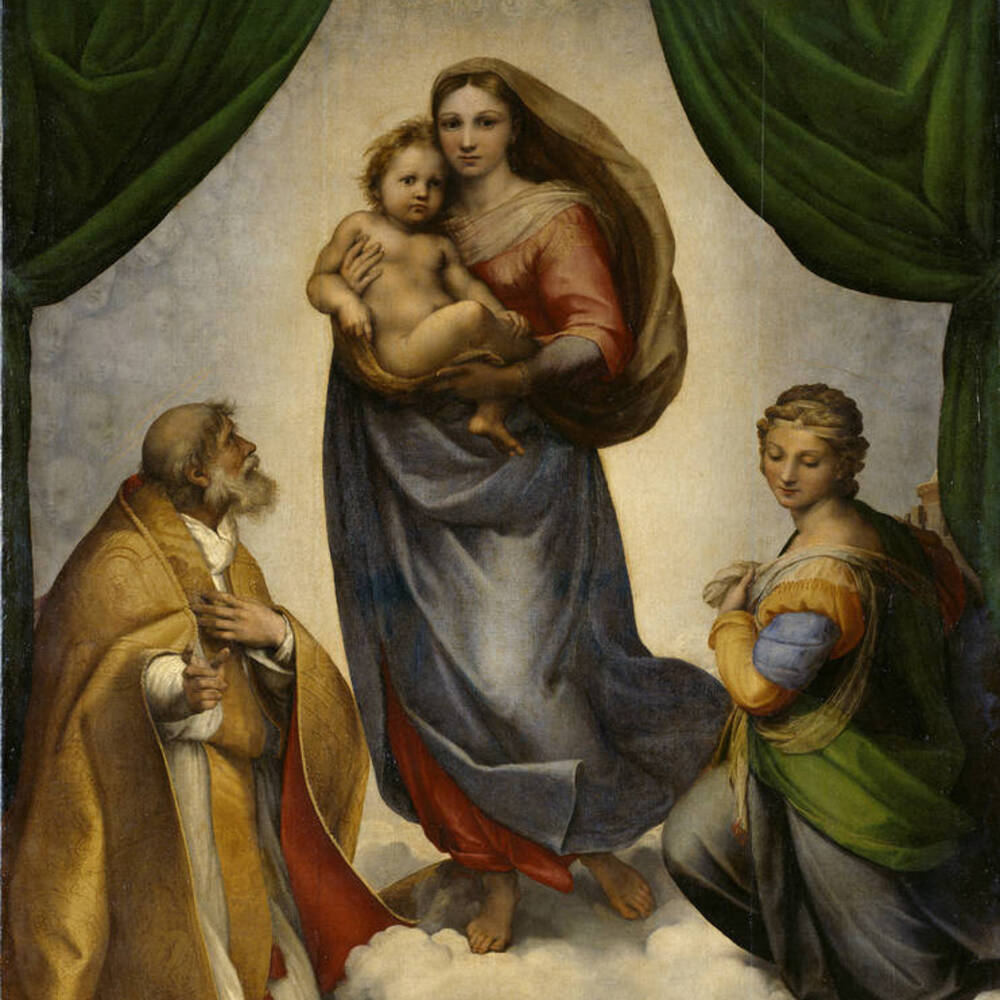




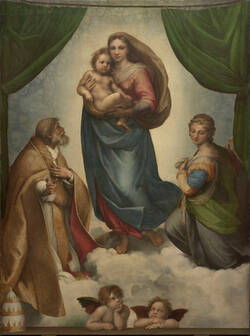

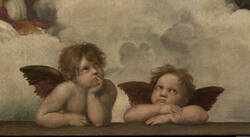
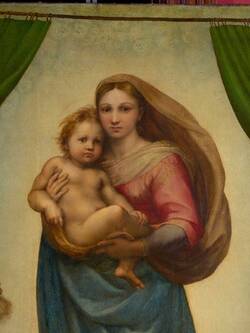
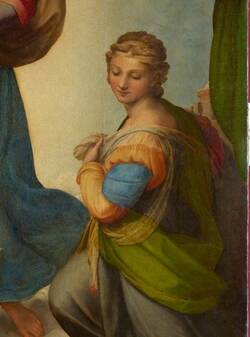

Raphael’s Sistine Madonna is an excitingly innovative work. He orchestrated the composition as a visitation, a vision we see each time we step in front of the painting – where we ourselves become actors in the scene.
Raphael had an incredible sense for the effect of painting and contraries in composition. The main figures form a triangle, with Mary as the focal point on the central axis. Calm and assured, she comes towards us over the clouds. Her fluttering robe indicates her movement, while its shape embraces mother and son to show how intimately they are connected. They both gaze out into the world, their expressions serious, as if they already know of Jesus’s coming suffering. On either side, they are flanked by two saints venerated in the San Sisto Church in Piacenza – the beatified Pope Sixtus and Saint Barbara. The aged Sixtus looks up, gesturing grandly, while the young Saint Barbara looks down modestly.
The barely discernible angels’ heads behind Mary embody the heavenly sphere – and are quite a contrast to the two cherubs in the foreground. The curtain and balustrade mark the border between heaven and earth.
In this room, Correggio’s altarpieces show the classic subject of an enthroned Virgin Mary and the saints – a scene Raphael turned into a heavenly vision.
Raphael had a well-organised workshop. But the Sistine Madonna is painted so brilliantly, it must be solely by Raphael’s own hand. He was, after all, a virtuoso painter.
With no surviving preliminary sketches and few traces of underdrawing on the painting, we can only partially recreate his painting process. We know Raphael must have sketched his figures first on the canvas in loose brushstrokes, and then quickly finished them – almost entirely without changes or corrections. The only signs of a special method of transferring a motif from paper to canvas can be found in the few black dots on some of the serrated edges of the papal tiara on the balustrade. During the painting process, Raphael also moved the eyes of the Virgin Mary slightly higher, most likely to make her gaze appear even more noble and sublime. The two cherubs in the lower foreground were also added towards the end of the painting process.
Raphael’s approach to painting the nimbus surrounding Mary and the Christ Child was also fascinatingly new. The nimbus is actually a soft yellow, but Raphael has mixed it with the bright blue of the sky so we cannot see it any other way than as a brilliant light.
When you look at this work, you should imagine the colours as somewhat brighter and more luminous. They are under old layers of varnish, which have yellowed and darkened down the years. But the varnish has been left, since removing these protective layers is a major task, and not one to be undertaken just for aesthetic reasons.
You have certainly seen these two picturesque cherubs any number of times – decorating everything from paper napkins to mugs, and even toilet paper. Their amazing global career, going far beyond the borders of good taste, began in around 1800. After 50 years in Dresden, Raphael’s Sistine Madonna was discovered by an admiring public. At that time, an artist from Kassel copied the two cherubs and shortly afterwards they were decorating porcelain and jewellery. By the late 1800s, they had crossed the Atlantic and were even appearing in ads for an American lard producer.
Yet Raphael had not originally planned them as part of the composition. From X-ray radiography, we know he initially painted only the clouds in the foreground. But evidently, he realised the composition needed something to bind it optically at the base.
His two cherubs, though, are not engaged in the usual angelic activities of singing, playing music or playing with the Christ Child. Instead, they are lolling over the balustrade, waiting. They are waiting for Mary – and, as they wait, they lead our eyes upwards towards her. Yet at the same time, they not only mark a border between the heavenly and earthly spheres, but also intensify the sense of spatial depth around the figure of Mary. And what’s more, they defuse the initial reserve beholders may feel in front of this solemn scene.
The Sistine Madonna is the only painting in the Old Masters Gallery set in a very different frame. This may resemble an original Renaissance frame, but it is actually a modern copy.
After the Second World War, the Sistine Madonna was seized by the victorious Soviet powers and taken to Moscow. The painting was returned to Dresden in 1956 – though without its frame, which has remained missing. The Sistine Madonna was then given a frame informed by Renaissance aesthetics.
In 2012, to mark the 500th anniversary of Raphael’s painting, the Dresden State Art Collections gave their famous picture this exquisite tabernacle frame recalling the work’s original purpose as an altarpiece. This tabernacle frame is based on the original frame of an altarpiece from Raphael’s time. After extensive research, the new frame was prepared working with historical techniques, and treated so it looks as if it has aged down the centuries.
Today, it sounds hardly credible – but in the mid-eighteenth century, the Dresden court regarded the Sistine Madonna as just second choice.
In those days, every ruling house worth its salt could boast a Raphael in its collection. So naturally, August III, Elector of Saxony and King of Poland, was keen on acquiring his very own Raphael. His dream was to own Raphael’s Madonna of Foligno, but the negotiations with the Church in Italy came to nothing. Only afterwards did he try to buy the Sistine Madonna, then a largely unknown painting in an abbey church in Piacenza. This small town in northern Italy was off the main Grand Tour, the route traditionally taken by young men from European noble families.
The painting dates from 1512 – and Pope Julius II is said to have personally commissioned Raphael to paint it for the main altar in Piacenza to celebrate the city joining the Papal States. For around 250 years, only the monks and the inhabitants of the town saw Raphael’s vision of the Virgin Mary. But then the abbey urgently needed money for refurbishment.
The price negotiations alone took an entire year. Finally, the price was agreed. The Sistine Madonna cost the vast sum of 25,000 scudi romani – more than 25 times the usual price for a painting of this size. The sale also required papal consent, customs problems to be resolved and last but not least, diplomatic pressure on the regional ruler.
With the contract finally sorted, the negotiators just had one goal – to transport the Sistine Madonna as quickly as possible to Dresden. Taking the painting over the Alps in winter was quite risky. Fortunately, an Italian artist accompanied the group of travellers and ensured this valuable work reached its destination unharmed. Since the canvas was too brittle to be rolled, it was kept in the stretcher frame. Wrapped in wax cloth, the painting was packed in a wooden case filled with straw, and to minimise vibration, the case was not nailed together. At one stop on the journey, the straw had even become wet and had to be replaced.
- Location & Dating
- c. 1512/13
- Material & Technique
- Oil on canvas
- Dimenions
- 269,5 x 201 cm
- Museum
- Gemäldegalerie Alte Meister
- Inventory number
- Gal.-Nr. 93